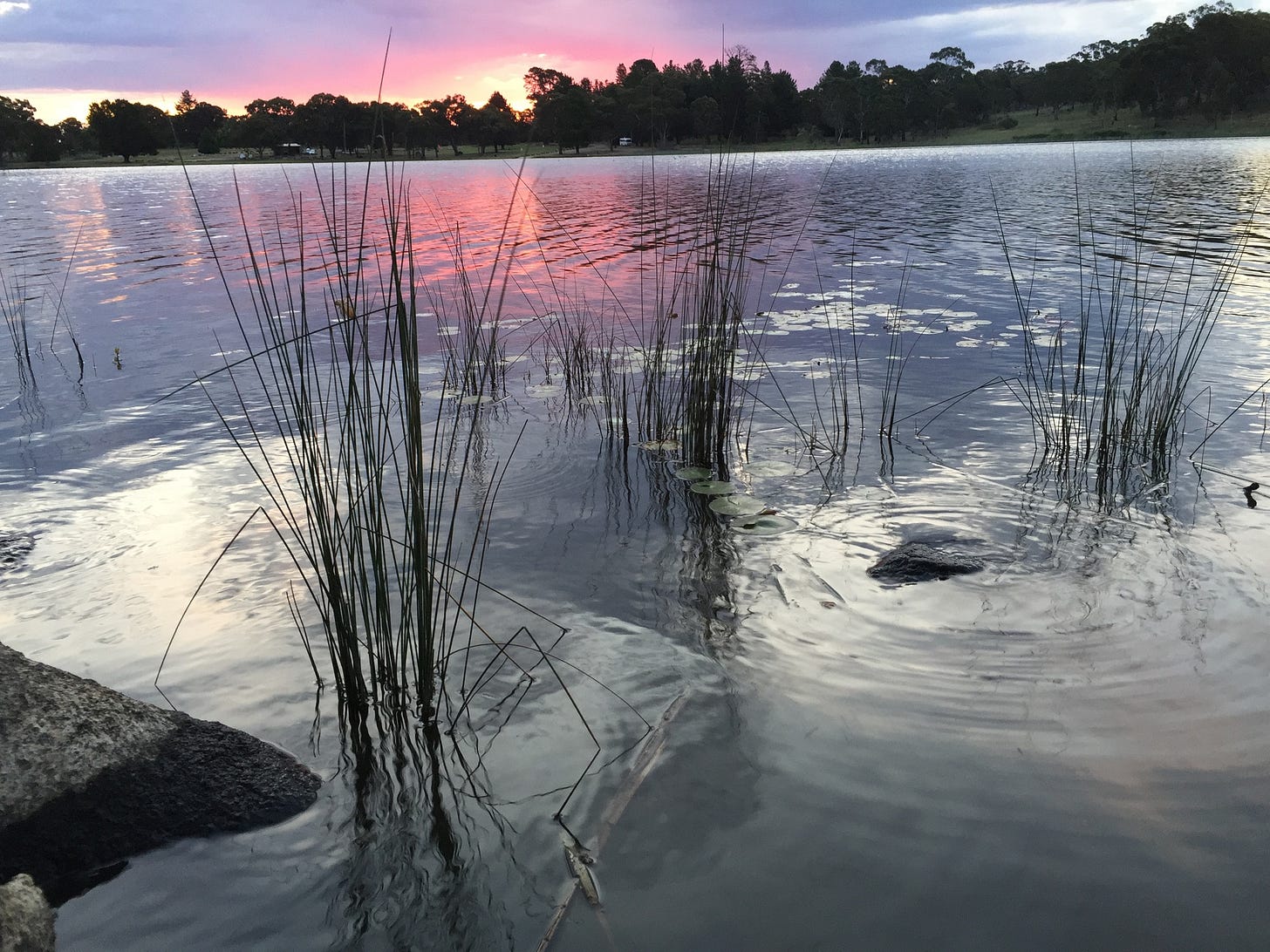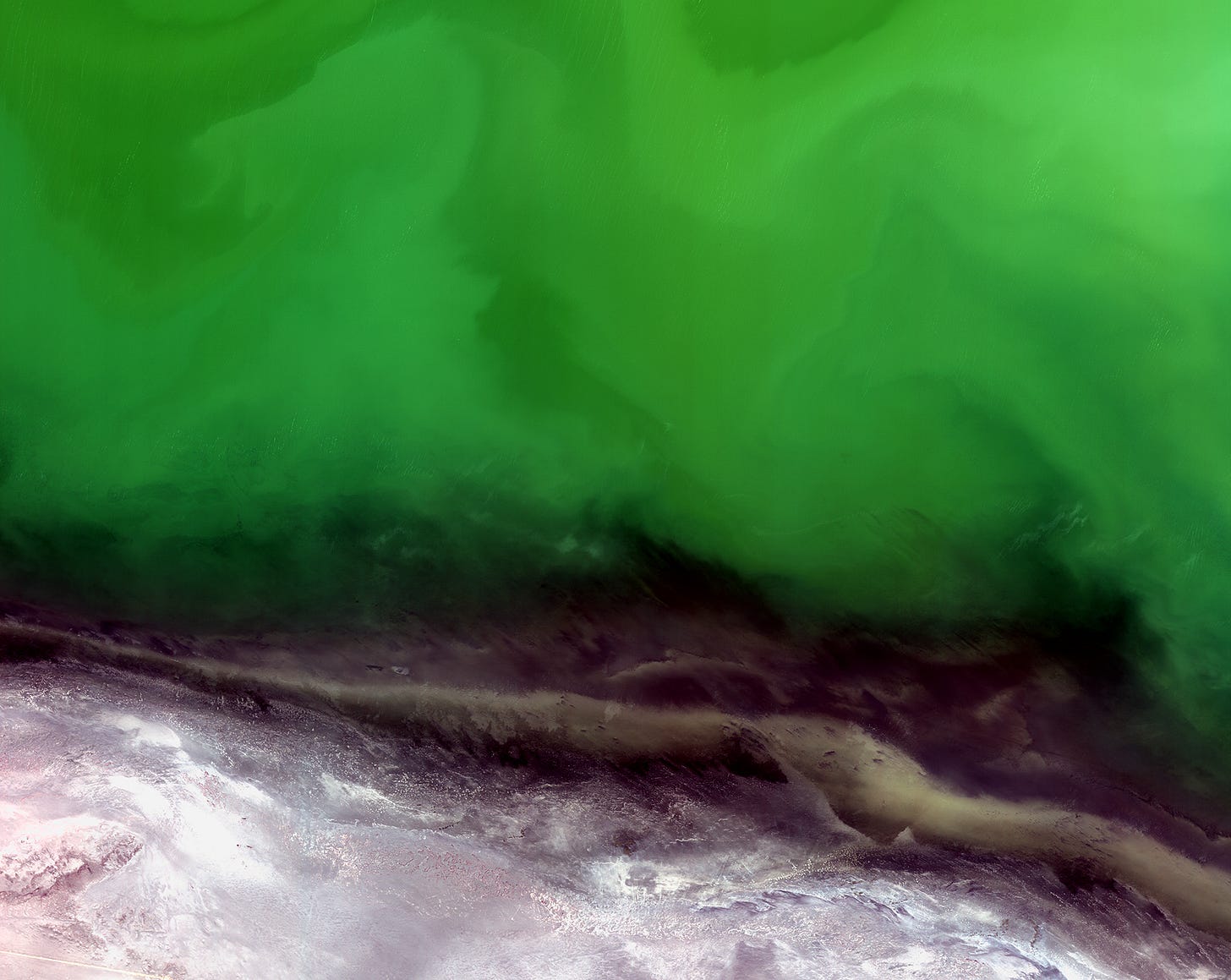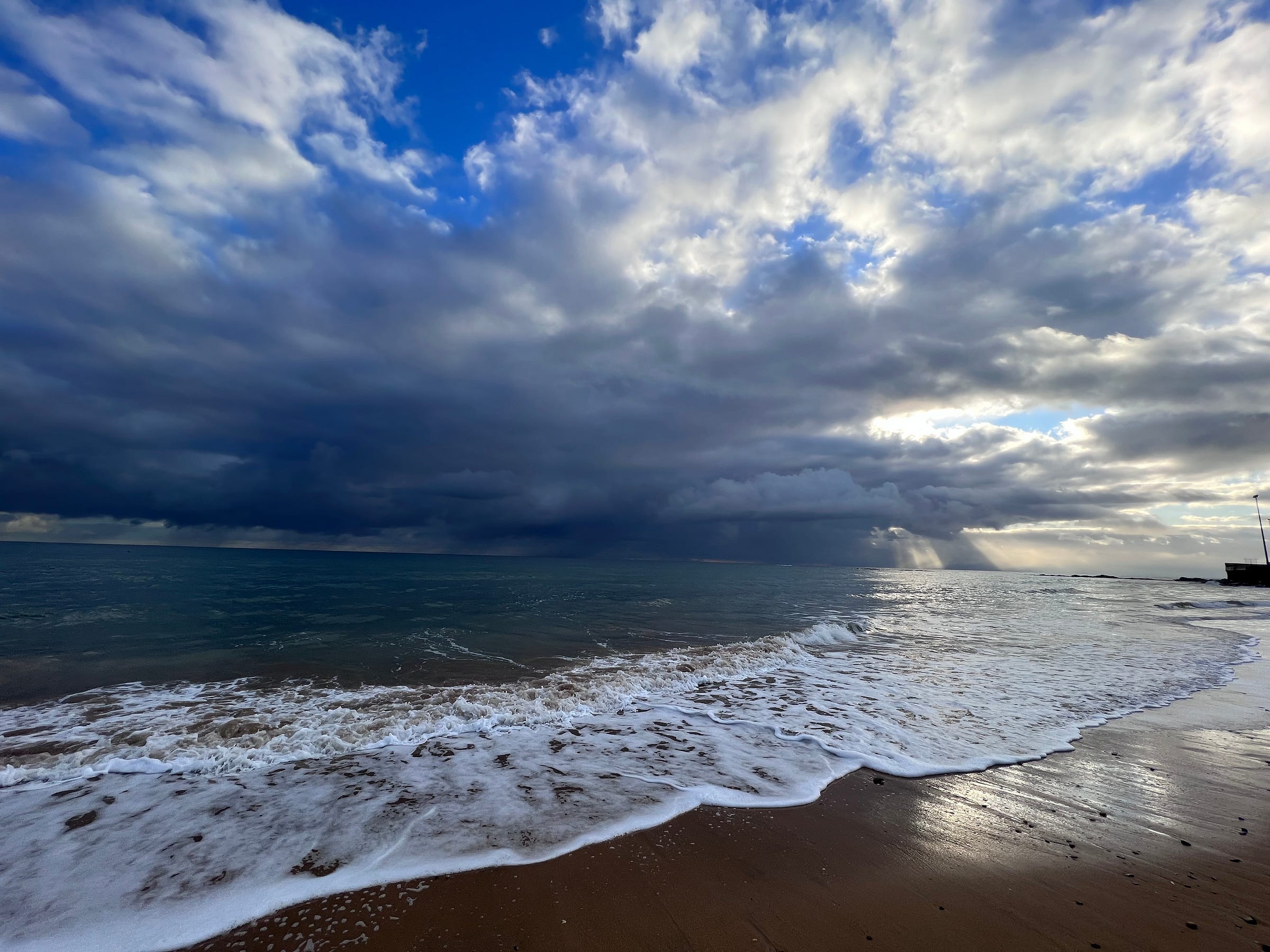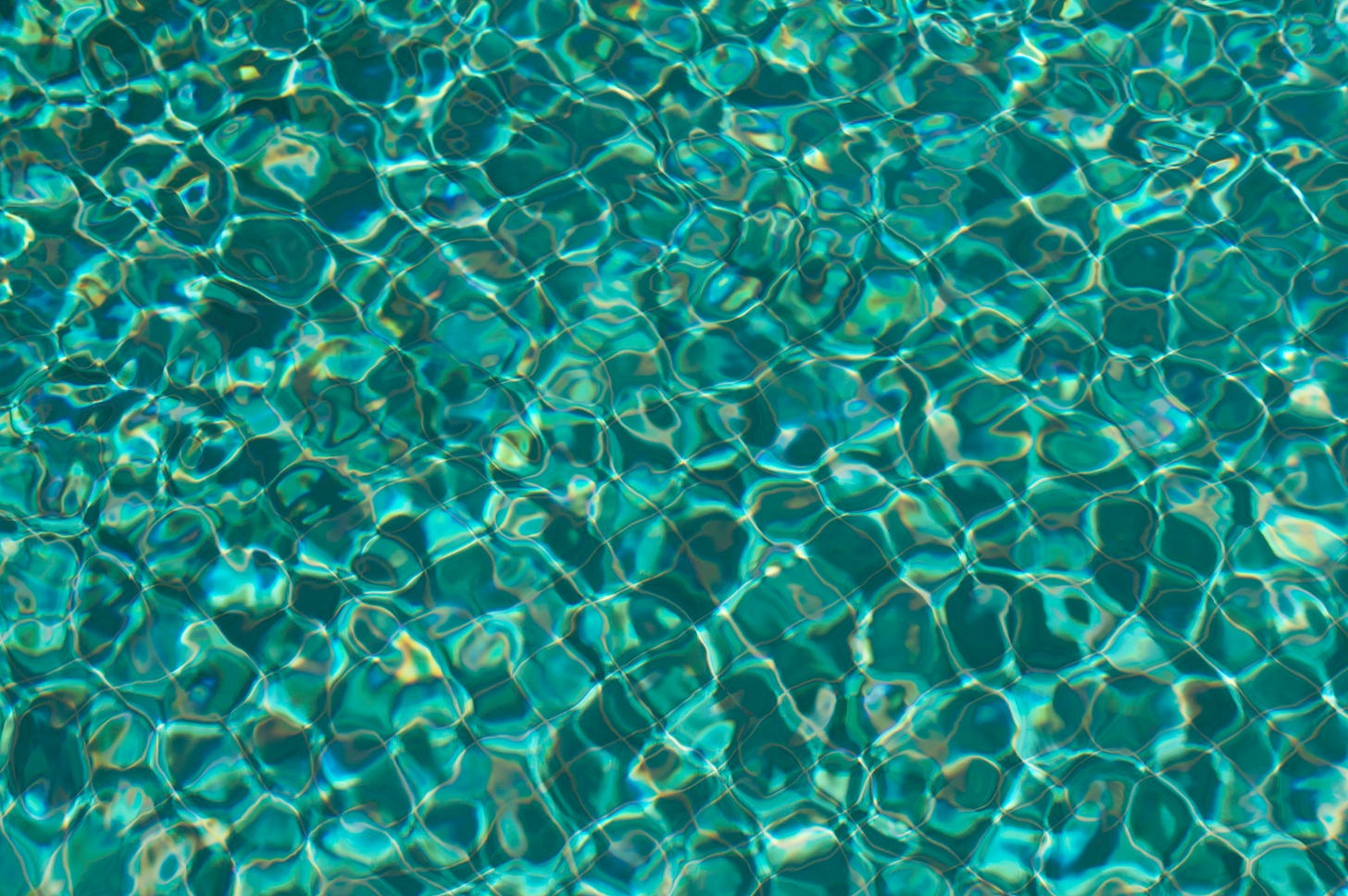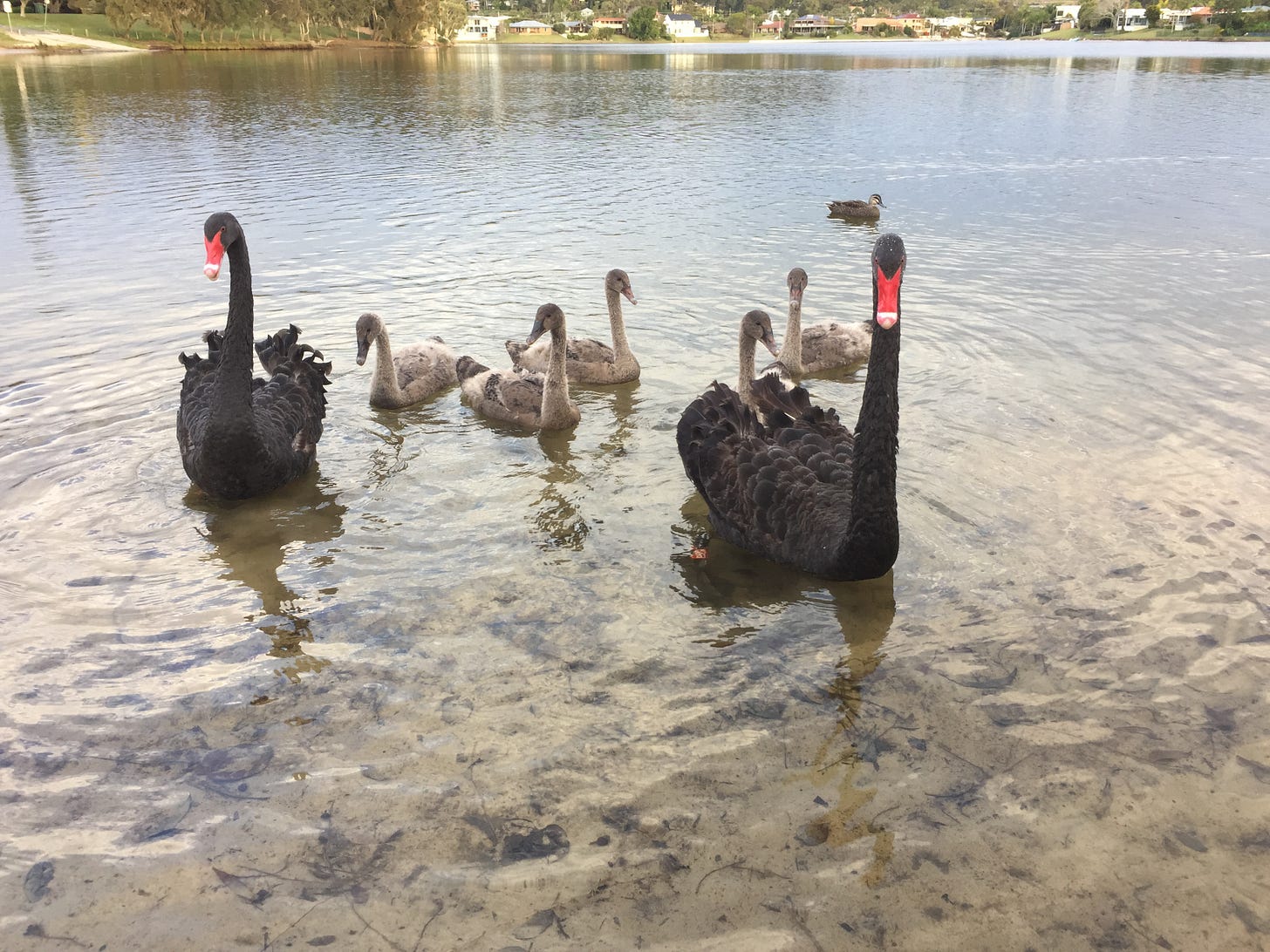Water & Hydration
A thirst quenching, myth busting exploration of sweet clean drinking water and optimal hydration

This article is a consolidation and update of questions people have asked, about water and hydration, from my clinic, consultancy, classes and articles over the last 2 decades. Note that there are NO AI generated images in this article - they are unedited photos and artwork for your enjoyment and wonder.
It is roughly divided into three parts 1/ Introduction to Water, 2/ Water related questions, concerns, myths and beliefs, and in the flow-up article - 3/ Common chemical contents of town water and home filtration strategies.
The subject of water is as huge as the earth itself, and indeed, intimately intertwined with life itself.
Here, of course, we can’t cover everything about the fluid that sustains life, but the aim is to “whet your appetite” so to speak with wisdom that may help. Wisdom = experience and knowledge gathered over time that is then applied to help others and ourselves.
We would also like to acknowledge Australian Indigenous knowledge and practices of water over at least the last 65,000 years and the current challenges they face with water access, quality and management in the light of increasing land and water economic developments. See - Drinking water quality issues | Aboriginal People and Groundwater
For Australian Indigenous people, water is a sacred source of life. The natural flow of water sustains aquatic ecosystems that are central to our spirituality, our social and cultural economy and wellbeing. The rivers are the veins of Country, carrying water to sustain all parts of our sacred landscape. The wetlands are the kidneys, filtering the water as it passes through the land. First Nations Peoples have rights and a moral obligation to care for water under their law and customs. These obligations connect across communities and language groups, extending to downstream communities, throughout catchments and over connected aquifer and groundwater systems. From - Water and Indigenous people
We should also confess to our obvious entitlement when it comes to access to mostly clean drinking water here in Australia (and in many other western developed countries). It breaks our hearts to see the travesty and tragedy in many regions and conflicts around the globe when adults and children can’t get clean water to drink.
This is highlighted even more so in a research article published a few weeks ago (August 2024) that found more than 4.4 billion people in poorer countries lack safe drinking water. This was bought to our attention by The Brockovich Report just yesterday - yes she is still advocating for clean water in the US and around the world.
However, even in our entitled countries, we need to be vigilant as to the preservation of the quality of our drinking water. Our previous article gave just one example of how we can damage this precious God/Nature given resource for generations to come if not careful and respectful.
If you are looking for a great book read, I highly recommend “ Call of the Reed Warbler” by Charles Massy. It’s about growing stuff in harmony with nature but contains two very interesting chapters on water.
So let’s jump in to a thirst quenching, myth busting exploration of sweet clean drinking water and optimal hydration.
Part 1 - Introduction to Water
Sources of Drinking Water
Here we outline the many ways we get water to drink. Each has its own set of challenges when it comes to making sure the water is healthy and free from impurities and contaminants.
Tap Water or Town Water
Quality of Town Water is informed by the latest Australian Drinking Water Guidelines 6, 2011, Version 3.8 Updated September 2022 and maintained and to some degree enforced, by the states and territories, water boards/authorities and local councils. States like NSW, also have their own, more specific NEW SOUTH WALES, PRIVATE WATER SUPPLY, Guidelines. Tap water off course can be town, bore, tank, stream, filtered water etc.
Ground water, Bore water or Well water
Ground Water sources can contain heavy metals, other chemicals and radioactivity, depending on the geology. According to NSW Health, groundwater supplies should undergo comprehensive water quality testing to ensure suitability for drinking water purposes.
Surface Water
Surface water is water that collects on the ground or in a stream, river, lake, reservoir, or ocean. Surface water is constantly replenished through precipitation, and lost through evaporation and seepage into ground water supplies.
Spring Water, Dam Water and River or Creek Water
Many people rely on these sources of water to drink. For geological and contamination reasons, testing is recommended especially when local populations grow, industry moves in, farming ramps up or historical mining activity have left legacy heavy metals.
Desalinated Water
Sydney has a desalination plant. Perth water is produced by two desalination plants that make up 48% of Perth's water supply.
Tank Water
Tank Water – can be collected from roof, a bore, a dam, stream or carted. Tank water should be tested at least every 5 years.
A "captured audience" environment
Drinking water available while in School, Hospital, Aged-Care Facility, Alcohol and Drug Rehab Centre, Correctional facilities or any “captured audience” situation.
And numerous other sources we will explore like
Rain Water, Filtered Water, Recycled Water, Bottled Water, Zippy Wall mounted dispenser, Water Coolers, Public Water fountains and Carted Water
Water use and Management
Historically, humans have mostly drunk water from natural sources like streams, rivers, and springs. Early human civilizations settled near these freshwater sources because they were crucial for survival. For thousands, if not millions, of years, these natural water sources were the primary supply, and they provided the cleanest and freshest water available at that time.
Streams and rivers were particularly important because they were constantly flowing, which helped to keep the water cleaner than stagnant bodies like ponds or lakes. Springs, where groundwater naturally surfaced, were also highly valued since the water was often filtered through layers of soil and rock. Rainwater was used as well, especially in regions where it could be collected and stored.
Water Quality
Back in the 1920’s, Viktor Schauberger was an Austrian forester and naturalist who developed a deep understanding of water and its vital role in ecosystems. Similar to the Australian Indigenous people, his work is rooted in the belief that water is a living entity with its own energy and needs to be treated with respect. Schauberger observed that water behaves differently depending on its temperature and how it flows.
One of his key ideas was that streams and rivers maintain their vitality when they are shaded by trees and forests. According to Schauberger, shade and cooler temperatures are crucial for keeping water healthy and full of life. The cooler, shaded environment created by forests helps water stay oxygenated and dynamic, promoting life within the water and in the surrounding ecosystem.
Schauberger also emphasised the importance of water’s natural flow patterns. He observed that when water flows in spirals or vortices—like you often see in natural streams—it preserves its energy and purifies itself more effectively. He argued that modern practices, such as straightening rivers and removing trees, disrupt these natural dynamics, leading to poorer water quality, erosion, and a decline in biodiversity.
His ideas on water temperature and the role of trees in protecting and nurturing streams have influenced some environmental and sustainable forestry practices today.
One of waters life-giving properties is its high specific heat - lowest at +37.5°C (+99.5°F). The term "specific heat" refers to the capacity and rapidity of a body to absorb or release heat. With a relatively small input of heat, fluids with a high specific heat warm up less rapidly than those with a lower specific heat.
How strange and how remarkable, that the lowest specific heat of this substance - water - lies but 0.5°C above the normal +37°C blood temperature of the most highly evolved of Nature's creatures - human beings. This property of water to resist rapid thermal change enables us, with blood composed of 80% water, to survive under large variations of temperature.
Just as good water is the preserver of our proper bodily temperature, so too does it preserve this planet as a habitat for our continuing existence. Water has the capacity to retain large amounts of heat and were there no water vapour in the atmosphere, this world of ours would be an icy-cold, barren wasteland. Water in all its forms and qualities is thus the mediator of all life and deserving of the highest focus of our esteem.
From The Water Wizard by Viktor Schauberger, Translated by Callum Coats
There are many other examples of preserving and even enhancing water quality but are beyond the scope of this current article. Later, in this article we will look at the current chemical composition of town drinking water and the possible flow on effects to human (and animal health). Interestingly, Schauberger was also seriously concerned about the effects on human health of the substance we deliberately put into our drinking water, even 100 years ago.
Viktor Schauberger also wrote a wonderful book called “Nature as Teacher”.
Water Quantity
Ancient civilisations in desert regions developed impressive techniques to cultivate greenery and sustain life in challenging environments through careful water preservation and management.
In modern times, there have been significant advancements in irrigation and water preservation techniques, especially in dry climates where efficient water use is critical. These include -
Drip Irrigation: This method is one of the most effective and water-efficient systems used today. Pioneered in Israel in the mid-twentieth century, drip irrigation delivers water directly to the roots of plants through a network of tubes with emitters. It minimizes water loss due to evaporation and runoff, making it ideal for arid environments. The precise control also reduces the growth of weeds and ensures that plants receive just the right amount of water.
Desert Agriculture and Mulching: In places like North Africa and the Middle East, mulching techniques have been used to preserve soil moisture. Mulch layers, often made from organic materials like straw or leaves, cover the soil, reducing evaporation and keeping the ground cooler. In more modern settings, plastic or other synthetic mulches are used to achieve similar goals. I use mostly organic sugar cane mulch.
Water Harvesting and Fog Nets: In regions like Morocco and parts of Latin America, communities use fog nets to capture water from the air. These nets are stretched across mountain slopes, collecting moisture from fog, which then condenses and flows into storage tanks. Additionally, water harvesting techniques that capture and store rainwater during the rainy season are common in arid regions like India and sub-Saharan Africa.
Desalination Plants: Israel, in particular, has been a leader in desalination, turning seawater into fresh water. Large-scale desalination plants using reverse osmosis are now providing a significant portion of the country’s drinking water. Although energy-intensive, advances are making this technology more sustainable.
Agroforestry and Permaculture in Drylands: Techniques like agroforestry, where trees are integrated into farming systems, have been used in dry regions such as the Sahel in Africa. These trees not only provide shade but also help retain soil moisture, enrich the soil with organic matter, and reduce erosion.
Subsurface Irrigation and Water Retention Strategies: Recent developments have also focused on underground water delivery systems that release water slowly at the root zone, minimising surface evaporation.
Part 2 - Water related questions & concerns
Water distribution in the human body
Having degrees in Biochemistry and Nutrition Medicine really helps in understanding the importance and metabolism of water to humans. The quote below is from the prescribed textbook I used during the 4 year Nutrition Medicine course back in 2006 and is from Sareen S. Gropper and Jack L. Smith. The book is the most advanced, thorough, clear and beautifully written book on Human Metabolism & Nutrition (yes, I’m a nerd) and has been updated at least six times.
Water accounts for about 60% of the total body weight in a normal adult, making it the most abundant constituent of the human body. In terms of volume, the total body water in a man of average weight (70 kg) is roughly 42 L. Water provides the medium for the solubilisation and passage of a multitude of nutrients, both organic and inorganic, from the blood to the cells and for the return of metabolic products to the blood. It also serves as the medium in which the vast number of intracellular metabolic reactions take place.
Total body water can theoretically be compartmentalised into two major reservoirs: the intracellular compartment, which includes all water enclosed within cell membranes, and the extracellular compartment, which includes all water external to cell membranes. Of the 42 L of total body water, the intracellular and extracellular compartments account for about 28 L and 14 L, respectively. The extracellular water is functionally subdivided into the plasma (the cell-free, intravascular water compartment) and the interstitial fluid (ISF). The ISF directly bathes the extravascular cells and provides the medium for the passage of nutrients and metabolic products back and forth between the blood and cells. In addition, the pericardial, pleural, peritoneal, and synovial spaces or cavities that are normally empty except for a small volume of viscous lubricating fluid are considered part of the ISF compartment.
The fraction of total body weight that is water and the percentage of total body water that is extracellular or intracellular do not remain constant during growth. Expressed as a percentage of body weight, total body water decreases during gestation and early childhood, reaching adult values by about 3 years of age. During this time, the extracellular water (as percentage of body weight) decreases while the intracellular water (as percentage of body weight) increases.
From - Advanced Nutrition and Human Metabolism, CHAPTER 12: WATER AND ELECTROLYTES, sixth Edition, 2013, by Sareen S. Gropper and Jack L. Smith
Is drinking demineralised water, like Reverse Osmosis (RO), Distilled Water or Pure Rainwater, harmful?
Reverse osmosis (RO) water is highly purified and contains very few minerals. This fact has sparked debate about whether drinking demineralised water is harmful, especially regarding its potential to leach minerals from the body.
Mineral Content in Water: One key argument against RO water is that it lacks essential minerals like calcium, magnesium, and potassium, which are naturally present in many sources of drinking water, albeit at low levels. Some studies suggest that long-term consumption of demineralised water could lead to mineral deficiencies if it’s a primary source of hydration AND food intake is low in minerals.
Mineral Leaching from the Body: The claim that RO water could "leach" minerals from the body is more controversial. The theory is that demineralized water is more acidic and could potentially pull minerals from your body as it passes through. However, there’s limited direct scientific evidence supporting this idea in healthy individuals with balanced diets. Your body primarily relies on food for its mineral intake, not water. More data to substantiate this later. If you’re getting enough minerals from your diet, drinking RO water alone is unlikely to cause significant health problems.
Electrolyte Balance and Health: In certain populations—like those who are very physically active, have specific medical conditions, or live in areas where food sources are also low in minerals— it may be useful to take extra minerals via a tablet supplement. More on this later when we talk about HYDRATION.
What are the main mineral in Australian drinking water and what are their average concentrations ?
Here’s a table that shows the main minerals typically found in Australian drinking water, their average concentrations, and their contribution to the Recommended Daily Intake (RDI) for an adult based on 2 litres of water. The mineral concentrations can vary by region, but I’ve used approximate average values for the table.
The table shows that while Australian drinking water does contribute to mineral intake, it provides only a small percentage of the RDI for most minerals, except for fluoride. Most essential minerals come from food sources, not water.

Calcium (Ca): Found naturally and sometimes added to drinking water. Helps with bone health and muscle function.
Magnesium (Mg): Supports nerve function, muscle health, and bone strength.
Sodium (Na): Typically present in low amounts in drinking water. It’s important for fluid balance but can be excessive if dietary intake is already high.
Potassium (K): Rarely found in significant quantities in water but is crucial for muscle function and fluid balance.
Fluoride (F): Often added to water in Australia to support dental health. High intake can be harmful, but the concentrations in drinking water are carefully controlled.
HYDRATION
Water from Food (Mediterranean Diet as an example)
The Recommended Daily Intake (RDI) for water in Australia, according to the National Health and Medical Research Council (NHMRC), is as follows:
Men: 2.6 liters (about 10 cups) per day
Women: 2.1 liters (about 8 cups) per day
These recommendations do include water from all sources, including beverages and food. On average, about 20-30% of our daily water intake comes from food, depending on diet. For someone following the Mediterranean diet, this percentage may be higher due to the emphasis on fruits, vegetables, and other water-rich foods. Fruits and Vegetables make up a large portion of the Mediterranean diet and are high in water content. For example, cucumbers, tomatoes, and watermelons can be over 90% water.
Estimation of Water from Food in the Mediterranean Diet
Studies estimate that individuals on a Mediterranean diet can get up to 30-35% of their total water intake from food alone. See table below…
Ten cups per day for men seems excessive in winter with very little sweating happening.
Hydration needs can indeed vary depending on the climate, activity level, and even the season. The guideline of 10 cups (2.6 litres) per day for men is a general recommendation and assumes average conditions. In winter, many experts suggest listening to your body and drinking to thirst. For many men, consuming around 1.5 to 2 litres (6-8 cups) per day might be more appropriate during winter, especially if their diet includes water-rich foods.
Factors that Affect Hydration Needs:
Climate: In cooler conditions, the body loses less water through sweating. As a result, the need for water from beverages can be lower.
Activity Level: If you’re less active and not sweating much, your water needs naturally decrease.
Diet: A diet high in water-rich foods (like fruits, vegetables, and soups) can reduce the amount of water you need to drink.
Metabolism: Your body’s metabolism can also play a role. When your body is not working hard to cool itself down, water requirements may be lower.
Signs of Adequate Hydration
Rather than focusing strictly on cup numbers, you can monitor hydration by:
Checking urine colour: Light yellow indicates good hydration.
Noticing thirst: If you’re rarely thirsty, you’re likely drinking enough.
Considering your energy levels and skin moisture: Dehydration can lead to fatigue and dry skin.
Hydration - NERD ALERT
Maintenance of fluid balance
Most available body water enters by the oral route as beverages (water and water-based beverages) or as liquids contained in foods. A relatively small amount of water is formed within the body as a product of metabolic reactions (metabolic water). These two sources together account for a daily intake of about 2,500 mL of fluid, of which the oral route contributes about 2,300 mL, or >90%.
The routes by which water is lost from the body can vary according to environmental and physiological conditions, such as ambient temperature and extent of physical exercise. At an ambient temperature of 68°F (20°C), about 1,400 mL of the 2,300 mL taken in is normally lost in the urine, 100 mL in the sweat, and 200 mL in the feces. The remaining 600 mL leaves the body as insensible water loss, so called because the subject is not aware of the water loss as it is occurring. Evaporation from the respiratory tract and diffusion through the skin are examples of insensible water loss.
From - Advanced Nutrition and Human Metabolism, CHAPTER 12: WATER AND ELECTROLYTES, sixth Edition, 2013, by Sareen S. Gropper and Jack L. Smith
1. Definition of Hydration
Hydration refers to the process of providing or absorbing water to maintain the body’s fluid balance. In biological terms, it is the presence of adequate amounts of fluid in the body tissues necessary for physiological functions. Water makes up a significant percentage of the body’s composition—about 60% in adults—and is essential for cellular functions, thermoregulation, digestion, and waste removal.
2. How Hydration Can Be Verified Objectively
Hydration can be objectively assessed using several methods:
Urine Specific Gravity (USG): Measures the concentration of urine. Values between 1.005 and 1.020 are generally considered well-hydrated.
Plasma Osmolality: Measures the concentration of solutes in blood plasma. Higher osmolality indicates dehydration.
Body Weight Changes: Measuring weight before and after activities (like exercise) can indicate fluid loss.
Bioelectrical Impedance Analysis (BIA): Measures the body’s total water content through electrical impedance.
Urine Color: Often used as a quick indicator (light yellow suggests good hydration).
3. Factors Influencing Optimal Hydration
Environment: Heat, humidity, and altitude affect fluid loss. Hot and humid conditions increase sweating, while high altitudes lead to faster respiration and fluid loss.
Activity Level: Physical exertion increases the need for fluids to replace sweat.
Diet: Foods high in water content (like fruits and vegetables) contribute to hydration. Sodium intake also affects fluid retention.
Health Conditions: Illnesses, especially those involving fever, vomiting, or diarrhea, can rapidly deplete body fluids.
Medications: Some drugs, such as diuretics, increase fluid loss.
Alcohol and Caffeine: These can have diuretic effects, although the impact varies and might not be as significant as once thought, depending on quantities.
Age: Older adults may have a diminished sense of thirst, putting them at higher risk of dehydration.
4. Can Someone Sense They Are Adequately Hydrated?
This requires awareness and some level of training:
Thirst: This is the body’s primary mechanism for signaling dehydration. However, relying solely on thirst can be inadequate for some people (e.g., the elderly or athletes).
Learning to Recognise Subtle Symptoms: With awareness, individuals can detect early signs like dry mouth, fatigue, and decreased urine output. Athletes, in particular, often learn to recognize dehydration signs more quickly.
5. Validity of the Urine Color Test for Hydration Levels
The urine color test is a simple, widely used method, but it has limitations:
Light Yellow to Pale Straw Color: Indicates good hydration.
Dark Yellow or Amber: Suggests dehydration.
Limitations: Factors like food, supplements (e.g., B vitamins), and medications can alter urine colour independently of hydration. It’s a helpful guideline, but not fully reliable on its own.
6. Hydration from Non-Water Beverages: The Case of Your Friend
It is indeed possible for someone to stay hydrated without drinking plain water. My friend claimed he never drank water and only drank tea and the occasional light beer during the day. (I always told him to be careful - he is still alive near 80 and is very active)
Indeed, beverages like tea, coffee, and even beer can contribute to daily fluid intake. While alcohol has a diuretic effect, moderate consumption (e.g., low-alcohol beer) can still provide fluids. The key is the total balance between fluid intake and loss.
7. Harmful Health Effects of Suboptimal Hydration
Short-Term Effects: Fatigue, headaches, dizziness, impaired cognitive function, and mood disturbances.
Long-Term Effects: Chronic dehydration can contribute to kidney stones, urinary tract infections, and impaired kidney function.
Severe Dehydration: Leads to confusion, low blood pressure, rapid heart rate, and in extreme cases, death.
8. Body’s Resilience and Adaptive Responses to Inadequate Hydration
The body has mechanisms to conserve water:
Hormonal Regulation: The release of antidiuretic hormone (ADH) helps the kidneys retain water.
Concentration of Urine: The kidneys can concentrate urine, minimizing fluid loss.
Behavioral Adjustments: Reduced activity, decreased sweating, and slower metabolism.
However, these adaptations are limited. Chronic underhydration can stress these systems, leading to negative health outcomes over time.
9. Water Loss in a Sauna
On average, a person can lose 0.5 to 1 liter (500 to 1,000 ml) of water in a 20-minute sauna session at 80°C. The exact amount depends on individual factors like sweat rate, acclimatisation, and body size.
HYDRATION and ELECTROLYTES
The concept of "cellular hydration" refers to the body’s ability to efficiently move water into and within cells, ensuring that they function optimally. While the water itself is the primary requirement for hydration, minerals, often referred to as electrolytes, play a crucial role in maintaining proper cellular hydration and overall fluid balance.
ELECTROLYTE BALANCE
Electrolytes are the anions and cations that are distributed throughout the fluid compartments of the body. They are distributed in such a way that within a given compartment—the blood plasma, for example—electrical neutrality is always maintained, with the anion concentration exactly balanced by the cation concentration. The cationic electrolytes of the extracellular fluid include sodium, potassium, calcium, and magnesium. These cations are electrically balanced by the anions chloride, bicarbonate, and negatively charged proteins, along with relatively low concentrations of organic acids, phosphate, and sulfate. The major electrolytes, are listed in the table below. The maintenance of pH and electrolyte balance is a responsibility that rests almost exclusively with the kidney.
From - Advanced Nutrition and Human Metabolism, CHAPTER 12: WATER AND ELECTROLYTES, sixth Edition, 2013, by Sareen S. Gropper and Jack L. Smith

1. Role of Electrolytes in Cellular Hydration
Electrolytes such as sodium, potassium, magnesium, and calcium are essential for:
Regulating Fluid Balance: Electrolytes help control the movement of water in and out of cells through osmosis. Sodium and potassium are particularly important in this process. Without adequate electrolyte levels, cells might not retain water properly, leading to either dehydration or overhydration.
Nerve and Muscle Function: Electrolytes are critical for transmitting nerve signals and ensuring proper muscle function. Imbalances can lead to muscle cramps, fatigue, and even more serious issues like arrhythmias.
Maintaining Blood Pressure and Volume: Proper electrolyte balance helps maintain blood pressure and blood volume, both of which are essential for transporting nutrients and oxygen throughout the body.
2. Minerals in Water vs. Food Sources
As we mentioned previously, the minerals required for hydration can come from both water and food:
Minerals in Water: Natural spring water and mineral water contain varying levels of electrolytes, which can support hydration. However, the mineral content in most drinking water (including purified water like reverse osmosis water) is usually low compared to dietary sources. In regions with very soft or demineralised water, the contribution from water is minimal.
Minerals from Food: A well-balanced diet typically provides all the necessary electrolytes. Foods like leafy greens, fruits (especially bananas and avocados), nuts, seeds, and dairy products are rich in the minerals needed for optimal hydration. See our posts below for more details on an eating regime that supports this.
3. Do You Need Minerals in Water for Optimal Hydration?
For Basic Hydration: You do not strictly need minerals in water to stay hydrated. Plain water without significant mineral content can still hydrate the body adequately, as long as you’re getting the necessary electrolytes from food.
For Optimal Cellular Hydration: While minerals in water can enhance hydration, especially during intense exercise, illness, or in hot climates, they are not essential if your diet provides sufficient electrolytes.
However in situations where electrolyte imbalances are more likely (e.g., endurance sports or heavy sweating), drinking water with added minerals (like sports drinks or mineral water) can improve hydration efficiency at the cellular level.
Foods that are good sources of key electrolytes
Here’s a table that lists foods that are good sources of key electrolytes (sodium, potassium, calcium, and magnesium), along with their typical serving size, the amount of the electrolyte in milligrams per serving and per 100 grams, and the percentage of the Recommended Daily Intake (RDI) for a woman of childbearing age.
Summary:
Sodium: Foods like sea salt, olives, and soy sauce are significant sources, providing a high percentage of the RDI. Even small amounts can contribute substantially to daily needs.
Potassium: Vegetables like spinach, beans, and sweet potatoes, along with fruits like bananas and dried apricots, are excellent sources of potassium.
Calcium: Dairy products, leafy greens, and fortified tofu provide substantial calcium. Sardines are a particularly rich source due to the bones.
Magnesium: Nuts, seeds, dark chocolate, and leafy greens are among the best sources of magnesium.
Plus
Parmesan Cheese: A high-sodium food that is also rich in calcium.
Halloumi Cheese: Provides a significant amount of sodium along with calcium, making it a flavorful source for those nutrients.
This list includes a broad range of food options that provide essential electrolytes, supporting hydration and overall health.
Optimal formula for an electrolyte drink
For prolonged athletic activity with significant sweating, an optimal electrolyte drink should replenish lost fluids, electrolytes, and provide a source of energy (glucose) to maintain performance. The key components include:
Optimal Formula for an Electrolyte Drink
An ideal electrolyte drink for athletes should contain:
Sodium: Around 300-700 mg per liter. Sodium is the primary electrolyte lost in sweat and is crucial for maintaining fluid balance.
Potassium: Around 150-300 mg per liter. Potassium helps with muscle function and prevents cramps.
Magnesium: Around 50-100 mg per liter. Magnesium supports muscle function and reduces the risk of cramps.
Calcium: Around 50-100 mg per liter. Calcium is involved in muscle contractions and nerve signaling.
Glucose (Carbohydrates): 4-8% solution (4-8g of glucose per 100 ml or 40-80g per liter). Glucose not only provides quick energy but also enhances the absorption of sodium and water in the intestines. The presence of glucose improves the absorption of sodium and water through the sodium-glucose co-transport mechanism in the intestines, which helps with faster rehydration.
DIY Electrolyte Drink Recipe
Here’s a simple homemade electrolyte drink recipe:
1 liter of water
1/2 teaspoon (about 2-3 grams) of salt (sodium)
1/4 teaspoon of potassium chloride (sometimes sold as "Lite Salt" or "NoSalt")
1 tablespoon of sugar or honey (about 15g of glucose)
Optional: 1/2 cup of fresh orange juice or lemon juice (for flavor and natural potassium)
Optional: 1/4 teaspoon of magnesium citrate powder
Recommended Commercial Electrolyte Drinks (Available in Australia and Internationally)
Several brands offer high-quality electrolyte drinks that are well-suited for athletes:
Australian Brands:
Hydralyte Sports: Designed for hydration and electrolyte replacement, Hydralyte Sports offers a balanced formula with glucose, sodium, potassium, and magnesium. It’s readily available in Australian pharmacies.
Shotz Electrolyte Tablets: Widely used by endurance athletes, Shotz offers tablets that can be dissolved in water, providing a good mix of sodium, potassium, and magnesium without excess sugar.
Endura Rehydration Formula: This is a popular sports electrolyte drink in Australia that includes sodium, potassium, magnesium, and carbohydrates for energy. It’s commonly used by long-distance athletes.
CAUTION - A colleague of mine recently went on the Kokoda Trail walk of 96 kilometres traversing extreme terrain and high altitudes for 7 days in very hot conditions and used the Hydralyte tablets and did well. I looked up the formula on their website and found the electrolyte tablets also contain Sucralose (Splenda - brand name) artificial sweeteners. Probably not a big deal if taking one off like he did for a few days, but I wouldn’t recommend them for long term use like regular Gym work. Sucralose has side effects that can be serious for some people and also disrupts the gut microbiome with long term use.
International Brands:
Nuun Sport: A well-known brand offering electrolyte tablets that are low in sugar but packed with essential electrolytes (sodium, potassium, magnesium, and calcium). Available internationally and in Australia.
Skratch Labs Hydration Mix: This drink mix is popular among endurance athletes and offers a balanced formula with glucose and electrolytes. It’s designed to replace what’s lost in sweat.
Tailwind Nutrition: Tailwind provides both electrolytes and energy in a well-balanced, easy-to-digest drink. It’s suitable for endurance athletes and available globally.
CAUTION…
The exact formula may need to be adjusted based on individual sweat rates, exercise intensity, and specific needs.
NERDY FUN FACTS about Water
Heads up - water intimately integrates with all life on earth.
Water’s unique atomic structure, with its flexible bond angles, polarity, and capacity for hydrogen bonding, gives it an array of remarkable properties. Water (H₂O) is a molecule composed of two hydrogen atoms covalently bonded to one oxygen atom.
Water has a bent molecular shape due to the two hydrogen atoms being bonded to oxygen at an angle rather than in a straight line. This angle is about 104.5 degrees. The bond angle in a water molecule is not fixed; it can change slightly due to interactions with other molecules. The flexibility in the bond angle allows water molecules to form a dynamic and complex network of hydrogen bonds, which contributes to its fluidity and unique behaviours.
High Heat of Vaporisation: A large amount of energy is needed to convert water from a liquid to a gas due to hydrogen bonding. This property is crucial for processes like sweating and transpiration in plants, which cool organisms by evaporating water.
Unlike most substances, water expands when it freezes due to the formation of a crystalline structure held together by hydrogen bonds. This makes ice less dense than liquid water, allowing it to float. This phenomenon insulates bodies of water, protecting aquatic life in winter.
Water is a polar molecule. Oxygen is more electronegative than hydrogen which gives oxygen a partial negative charge and hydrogen a partial positive charge. Water’s polarity makes it an excellent solvent for many substances, particularly ionic and polar compounds. It can dissolve salts, sugars, acids, and gases, facilitating chemical reactions in biological systems.
Anomalous Expansion:
Water exhibits an anomalous expansion between 0°C and 4°C, meaning it expands upon cooling, reaching maximum density at 4°C. This property is crucial for the seasonal turnover in lakes.
Surface Tension “Bubbles”:
Water’s surface tension is high enough to support small objects that are denser than water, like needles or paperclips, when carefully placed on its surface.
Thermal Conductivity:
Water has relatively high thermal conductivity compared to other liquids, enabling efficient heat transfer in biological systems and the environment.
High Dielectric Constant:
Water has a high dielectric constant, meaning it can reduce the electrostatic forces between charged particles. This property is why water is so effective at dissolving salts and other ionic compounds.
Autoprotolysis:
Water can self-ionize in a process known as autoprotolysis, where two water molecules react to form a hydronium ion (H₃O⁺) and a hydroxide ion (OH⁻). This characteristic is fundamental to the concept of pH.
Viscosity Anomaly:
The viscosity of water decreases with increasing pressure, which is unusual compared to most other liquids. This characteristic is important for deep-sea organisms and processes.
Refractive Index:
Water has a relatively high refractive index (about 1.333 at 20°C), meaning it bends light significantly. This property is crucial for optical phenomena such as rainbows and the behavior of light in aquatic environments.
Capacitance:
Water can act as a dielectric medium, meaning it can store and release electrical energy in capacitors. This property is used in some biological membranes and technologies.
Anomalous Diffusion:
Water molecules exhibit anomalous diffusion, where they move faster in some contexts than would be expected based on temperature and viscosity alone. This property is still being studied but may relate to hydrogen bonding dynamics.
Electromagnetic Fields (EMFs) and Water
Some of us (myself included) may have the idea that keeping an urn or container of clean drinking water near an electric current, such as a power outlet, might have negative or even positive effects on the water quality. This is primarily rooted in concerns about electromagnetic fields (EMFs) and their potential interaction with water. This topic is an area of speculation more than established scientific consensus, but here is an overview of what is known or hypothesised…
Electromagnetic fields are generated by electric currents, such as those found near power outlets, electrical wiring, and appliances. These fields vary in strength depending on the voltage and the distance from the source.
Water is a polar molecule, meaning it has a positive and negative side, and it can be influenced by electromagnetic fields.
Some hypotheses suggest that strong electromagnetic fields might affect the molecular structure of water, potentially altering its properties. However, the fields generated by typical household electrical currents are relatively weak.
The practical significance of such changes, especially with the weak EMFs found near household outlets, remains unclear.
There is no credible scientific evidence that the proximity of water to a standard electrical outlet or EMFs affects the chemical or microbiological quality of drinking water.Extensive research has however been conducted on the potential health effects of EMFs, particularly from higher exposure sources like power lines or cell phones or cell phone towers. (see our previous article how Telstra was taken to court in a class action over this very thing) For low-level EMFs, such as those from household electrical devices, there is currently no conclusive evidence linking them to significant health risks, yet in my opinion, precaution may be useful by keeping sensitive substances like water at a distance from these fields.
I conducted a little experiment and research myself into this area, as we store about 15 litres of filtered clean water near a power plug outlet on a kitchen bench top and wanted to lean into the precautionary principle. I used a non-contact voltage tester (DETA brand - Australia) to test the power outlet for EMF even when turned off and nothing plugged in. It beeped furiously until about 2-3 inches from the source (power outlet). A non-contact voltage tester only measures the voltage component of EMF and it definitely registered the presence of voltage within the power outlet. To generate a magnetic field in the power outlet would require current to be running through (which is not happening as nothing is plugged in and turned on). A gauss metre will measure current. I don’t have one at this stage and as mentioned, don’t need one as no current is flowing. RESULT of the experiment: keep the water urn at least 6 inches from the non-current producing power outlet as the electrical field is negligible at that distance. (electric field strength decreases exponentially as distance from the source increases)
Part 3 of this Article will be coming in the next few weeks…
Part 3 - Composition of town water and home filtration strategies
Town Water
Quality of Town Water is informed by the latest Australian Drinking Water Guidelines (ADWG) yet maintained and to some degree enforced, by the states and territories, water boards/authorities and local councils. States like NSW, also have their own, more specific guidelines. See Australian Drinking Water Guidelines (ADWG, 2022)
We will cover this and the more in relation to long term health in the next instalment.






